A California Beekeeper Reports from Down Under
A California Beekeeper Reports from Down Under
Randy Oliver
ScientificBeekeeping.com
First Published in ABJ in Sept. 2008
Australia is in a unique situation—long-term drought, a massive feral bee population, honey flows every month of the year, a burgeoning demand for almond pollination, and the varroa mite knocking at the door.
I’m freshly returned from an all-too-brief visit to the Land Down Under. Australia is a long, long ways from my home state of California, taking the better part of a day spent packed like a sardine into a big aluminum tin with wings. And upon arriving, the shock continues—not only are you now standing upside-down on the planet, but you’ve gone from summer to winter, and night to day. Even worse, your stomach is wrenched by the drive away from the airport because everyone drives on the wrong side of the road, and at each turn into traffic, your jetlag-fogged brain screams out that you’re going to crash into oncoming traffic.
However, once safely escorted to beekeepers Ken and Shirley Olley’s lovely home, my wife Stephanie and I could begin to enjoy warm Australian hospitality, and learn about this fascinating country. Australia is roughly the size of the continental United States, and is the flattest and driest inhabited continent (most of the human population dwells near the coasts), with the oldest and least fertile soils. Since it has been isolated from the rest of the continents for some 39 million years, nature has evolved a flora and fauna distinctly different from anything else on Earth.

Aerial view of the mighty Murchison River in Western Australia. The ridges are the remnants of ancient coral sand dunes blown by the constant winds, and solidified by the scant rain. For most of the year, the river consists of only dry sand bed, but is shown here green with vegetation.
A tough and unique flora
The ancient weathered soils have had most of the basic nutrients necessary for plant growth leached out of them. Therefore, the native plants have had to adapt not only to drought (and frequent fire), but to poor soils. In addition, the high contents of various metals in the soils (which results in bright colors, and a thriving mining industry) gave rise to a widely diverse flora adapted to tiny microhabitats. One also quickly notes that most Aussie flora is either tough and prickly, or strongly resinous!
Of special interest to beekeepers, is that many Aussie plants were adapted to non-insect pollinators, such as possums, bats, and honeyeater birds. As a result, nectar is often produced copiously in each blossom. Some nectars are also high in antimicrobial properties, and are marketed for use in the healing of wounds, notably those infected by antibiotic-resistant staphylococcus bacteria. Melaleuca and Jarrah honeys fall into this category. At the West Australian conference, beekeeper Peter Taylor described his 12-year quest to locate the floral source of yet another antimicrobial honey, which turned out to be twice as potent as Manuka (Leptospermum)! Peter was generous in his sharing of information with other beekeepers, and has set up a marketing agreement to the benefit of all parties—a wonderful example for us all.
Several of the dominant groups of plants, such as the eucalypts and banksias, produce huge quantities of nectar and pollen, eagerly utilized by honey bees. The eucalypts are the dominant species of trees, with some 700 species. I grew up with Eucalyptus in California (mostly blue gums), and indeed, much of Australia looked superficially similar to California landscapes. However, it was fascinating to see familiar ecological niches that I would associate with pines, firs, oaks, or sycamores instead occupied by various species of Eucalyptus.
Individual Eucalyptus species are adapted for each climate, soil type, and moisture level. Some are among the tallest trees on Earth (now being heavily chipped for the Asian market). Others, such as the heavily-logged Jarrah, form huge lignotubers underground to store food and water to allow them to regenerate after fire. Many have beautiful hard woods, some more dense than water. Jarrah produces a dense mahogany-like, highly rot- and insect-resistant wood that has been used for furniture, railroad sleepers, wharf pilings, and road underlayment (I learned a great deal about Jarrah, since my main hosts, Peter and Jenny Detchon live in a jarrah forest).
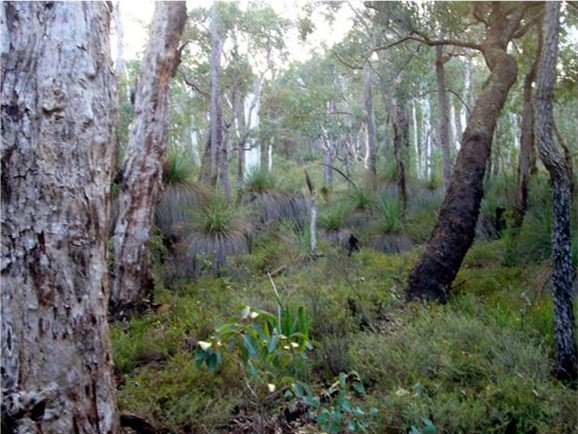
A misty Jarrah forest near Peter Detchon’s home in Western Australia. The pom-pom flora are Blackboys or Grass Trees—which are highly adapted to resist fire, recover, and bloom.
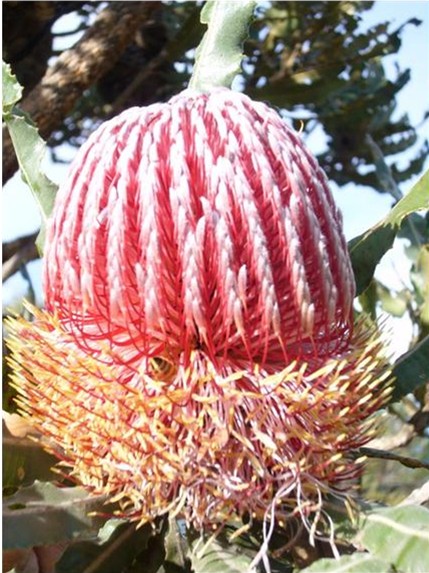
One of many species of Banksia, which grow on Australian coastal lands. Note the size of the flower relative to the bee’s abdomen in the center. Banksias produce copious nectar, but are threatened by dieback and too frequent fire.
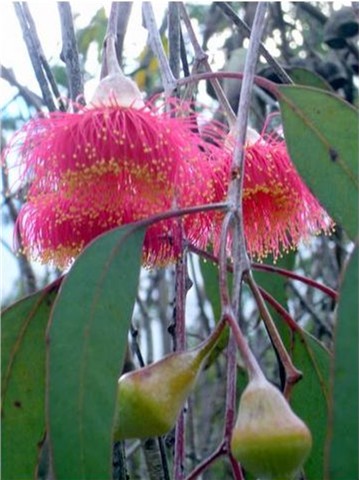
Gungurru, or Silver Princess (Eucalyptus caesia) flower and its buds This is one of the more showy eucalypt flowers. The downward-facing blossoms prevent rain from washing out the nectar.
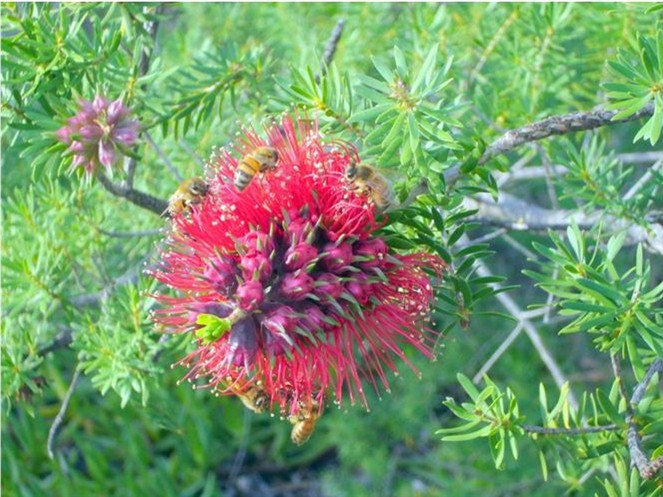
Kunzea baxterii, one of the many Bottlebrush-like flowers, being eagerly worked by bees.
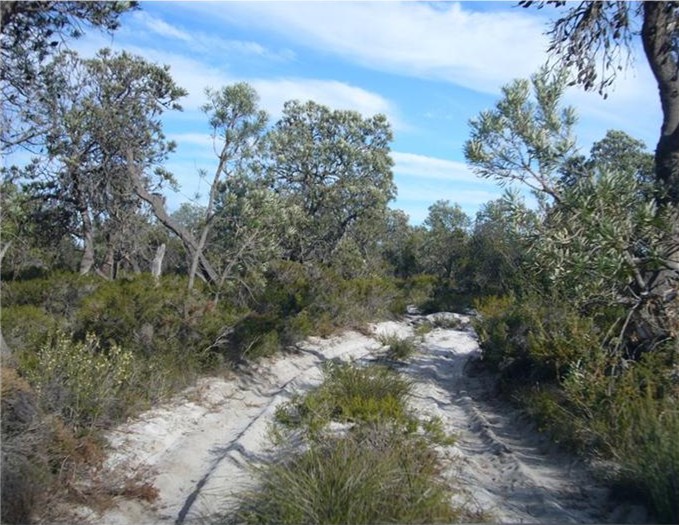
The entry to one of Peter Detchon’s sandy bee yards during the midwinter honeyflow.
The difference from California is that the Australian forest trees and shrubs bloom and produce honey in a big way! In Western Australia (WA), there are honeyflows every month of the year (if there is enough moisture), and beekeepers can in good years pull a deep super of honey every two weeks throughout the year! You do the math.
Unfortunately, the Australian flora is threatened by drought, clearing, over harvesting and overgrazing, frequent controlled burning, as well as uncontrolled wildfires, and invasion of exotic species. In addition, in the productive coastal and farm lands, drought and land clearing are allowing the salt water aquifer to rise close to the surface in many areas, with dire consequences.
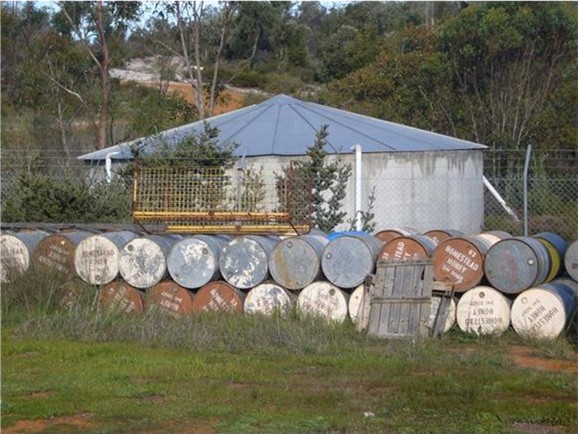
Water is precious in much of Australia. This is Peter Detchon’s rainwater storage cistern. Many houses and bee businesses depend upon rainwater diverted from roofs for their water supply.
Invasives, Biosecurity, and Quarantines
The native Australian flora and fauna have been hard hit by invasive exotic species–animal, plant, and fungi. Most readers have likely heard of the problems with rabbits, feral cats, and cane toads, but did you know that olive trees are a weed, and that camels, donkeys, and rainbow lorikeets are pests? One problem that especially struck me was the devastation of the native flora by the imported fungus Phytophthora, which causes “dieback” disease of many of the native trees and shrubs.
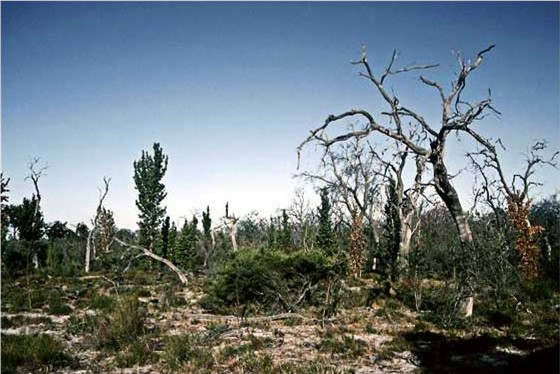
An example of the destruction caused by the introduced fungus Phytophthora in a Banksia woodland. Photo: John Hicks
Dieback leaves productive forests looking like standing skeletons of once proud trees, and affects all the other species that depended upon them, including honey bees. Of course, the European honey bee, which was introduced some 180 years ago, is itself an invasive exotic species. It has become firmly established as a naturalized inhabitant of most all but the most arid areas of the continent. There are concerns by some that the honeybee may compete with native species for forage or nest sites, but these have been largely discounted by scientific studies [1].
The feral population will continue to thrive until yet another exotic species, the varroa mite, arrives. At that point an interesting experiment will take place. Will the vast unmanaged feral population of bees be able to rebound quickly as did the South African and New World Africanized bees, or will it remain decimated for some time, as the populations of native or feral European bees are in Europe and North America? Only time will tell.
I must mention yet another exotic, Patterson’s Curse, aka Salvation Jane (because it may be the salvation of sheep during drought). This invasive pasture weed can be toxic to livestock, yet beekeepers seek it out for the fine honey that it produces.
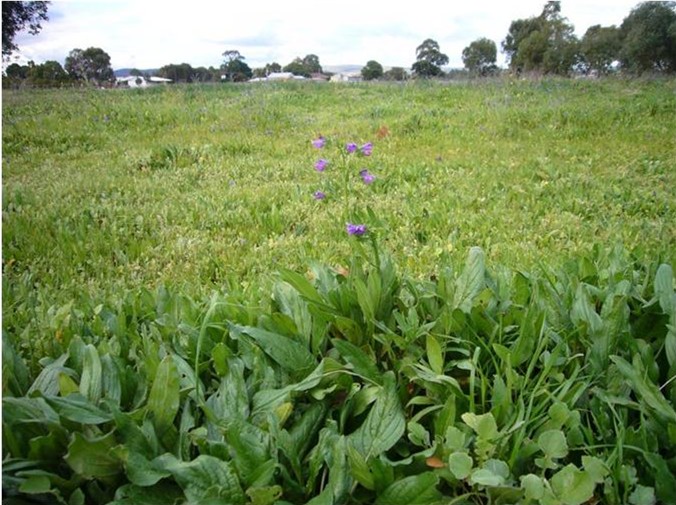
A solitary Salvation Jane flower (Echium plantagineum), an invasive weed of disturbed areas, which produces “a delightful lemon yellow coloured honey. It smells intriguingly of savoury herbs – thyme and oregano – but has a smooth, sweet palate with touches of candied almonds.” (description from The Honey Farm). Where the weed grows uncontrolled, the ground is a carpet of blue during bloom time.
Australians are concerned about invasive species, and the Australian State Quarantine Inspection Services keep a close eye on travelers at border checkpoints and airports. (I expected the same upon my return to the U.S., and dutifully checked the boxes on the entry form to say that I was carrying plant products, animal products, and had been to a farm. Unfortunately, since Homeland Security now handles Agricultural Inspection, no one cared).
Australian bees do not yet have tracheal or varroa mites, but have recently picked up small hive beetle and Nosema ceranae. Western Australia, which is isolated from the rest of the county by vast swaths of desert, is especially vigilant for new pests. WA does not allow the import of nonpasturized honey, for fear of introducing European Foulbrood.
The Australians are keen to remain free of varroa for as long as possible. Unfortunately, the mite is currently found in both nearby New Zealand and New Guinea, plus there is considerable air travel and shipping between Asia and the continent. Asia, of course, is the original home of varroa, plus the potentially invasive Eastern honeybee Apis cerana, and its associated parasites and diseases. The Aussies are resigned to the fact that they will eventually be invaded by varroa—the only question is whether it will be sooner, or later. The other imports that they scrupulously wish to avoid are either the African savannah or Cape bees, which would likely completely displace their feral population.
Beekeeping and Agriculture
Honey bees are responsible for most agricultural pollination, since most food crops are of European, Asian, or New World origin (with the notable exception of the macadamia nut–which is native). Beekeepers receive rent to pollinate a number of crops, such as stone fruits, vine crops, seed crops, avocados, kiwis, and especially, almonds. Almond plantings are growing exponentially, and will soon require the services of the majority of the managed colonies that are permitted to move between the states. Quarantines to restrict the movement of future bee pests, such as mites, may create serious problems for growers requiring pollination services.
Many other crops, such as apples, are largely pollinated by the feral population of honey bees. This will likely change, once the varroa mite arrives. The Australians are generally aware of this, and inroads are being made to prepare for an integration of beekeeping into Australian agriculture [2, 3].
The Beekeepers
The beekeepers that we met were open, friendly, innovative, and hard working. It was a surprise to them to hear that those of us who exist with varroa considered beekeeping to be “easy” for them! Australian beekeepers do not use any miticides, or fumagillin for nosema, and only use limited Terramycin for European foulbrood in some states. As a result, Australian honey and beeswax may be sold to organic markets. To me, it felt like going back in time to “the Good Old Days”!
In Western Australia, no antibiotics are used at all. For AFB control, many practice “barrier management,” in which supers and frames are individually marked, and returned to the same hives from which they were taken [4]. Hive tools may be scrubbed clean and sterilized between hives, and boxes are sterilized by dipping into hot paraffin (more on this in a following article). These measures minimize the spread of spores, so that AFB can be controlled by hygienic behavior and the burning of infected frames. The amount of detail involved in barrier management came as a surprise to this American beekeeper!
I was munching on an Australian almond-flavored biscuit, and was struck by the strong flavor of benzaldehyde (from the imitation almond extract). I found that neither this bee repellent, nor any other, is permitted for fume boards due to fear of honey contamination. This was a bit of a surprise to me, since I’m sure that I ate more benzaldehyde in the biscuit than I would get in several gallons of fumed off honey! (My readers are likely aware of my amazement at regulatory inconsistencies!)
Since there are year-round honeyflows in some areas, beekeepers may move (“shift”) their colonies a dozen or more times a year to chase the flows. A beekeeper may set bees down, check the next day to see if they are making honey, and if not, immediately move them somewhere else! The successful beekeeper must have many locations (that can cost thousands of dollars for the government licenses to take “produce,” whether the honeyflow materializes or not) and a good feel for the erratic nectar flows.
Whilst most extracting is now done in modern central plants, there are still some tough beekeepers who spend most of their time in the bush with mobile extracting trailers, only returning home on weekends to drop off filled drums, and do laundry. In good seasons, honey may be pulled from the hives every two weeks, and most beekeepers run queen excluders above a single brood chamber, with two deep honey supers continually rotated above. With this sort of intensive management, most commercial beekeepers can only run a few to several hundred colonies.
Since honeybees did not evolve with the Australian flora, the pollens may be lacking in certain fatty and amino acids. The Red and Spotted Gums (gums are eucalypts that weep gummy resins from bark wounds) are excellent bee forage for buildup, but the winter honeyflow of the popular White Box may prove disastrous—its pollen lacks the amino acid isoleucine, and colonies may collapse after putting on a large honey crop during the stressful cold weather [5].
Labor is in short supply, especially in Western Australia, where good paying jobs at the mines lure away strong young men. Much beekeeping labor comes from Philippinos on work visas, who are treated like members of the family. Australia has a 35-hr work week, strong labor safety and minimum wage laws, and a limit as to how much you can lift (lifting a deep super of honey by hand is apparently technically illegal). As a result, I was struck by the number of different types of lifting and loading devices that I saw (also to be covered in a subsequent article).
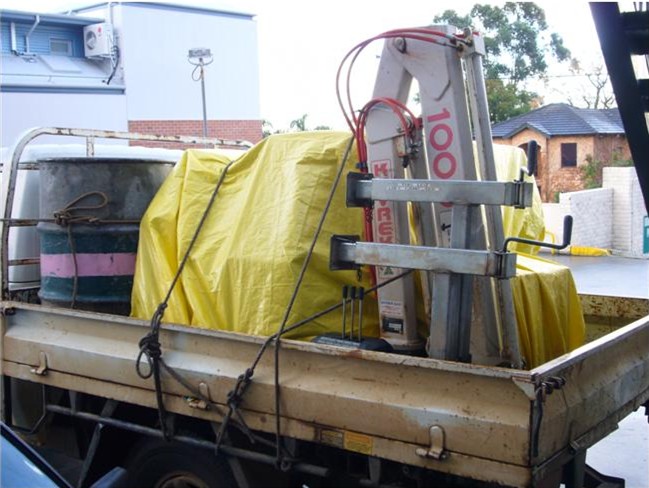
A typical small bee truck with a lift. Trucks with pickup beds are called “utes” (pronounced “yoot”). This truck has a steel bed with drop-down/removable sides, but much more common are a similar design made from flat aluminum (see www.uteltd.com/), which really impressed me! Note the typical hydraulic lift, and tie-off rod.
Most every bee truck had some type of loader, as well as the requisite “roo bar” on the front. Kangaroos bound constantly across roads in the bush beginning at dusk, and collisions with vehicles are frequent, expensive, and sadly, murderous for the kangaroos.
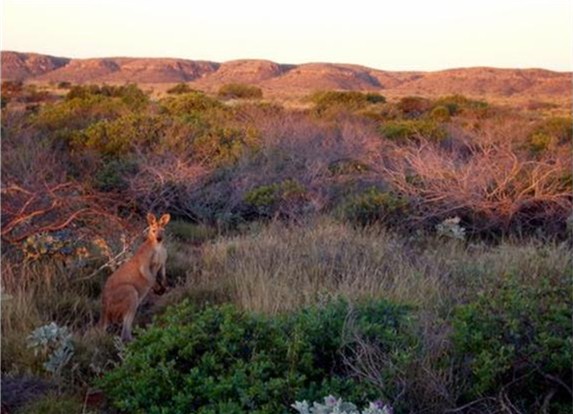
A kangaroo at the roadside in Western Australia, in typical tropical bush country. Similar to deer, you never know when the ‘roo will suddenly bolt in front of you.
The honey houses that I saw were clean and well organized. Unlike the typical once or twice a year extraction in the U.S., honey may be extracted every week of the year, and each run may be from a different floral source. Mobile extracting units are also common, since the bee yards may be hours distant, and supers must be quickly returned to the hives.
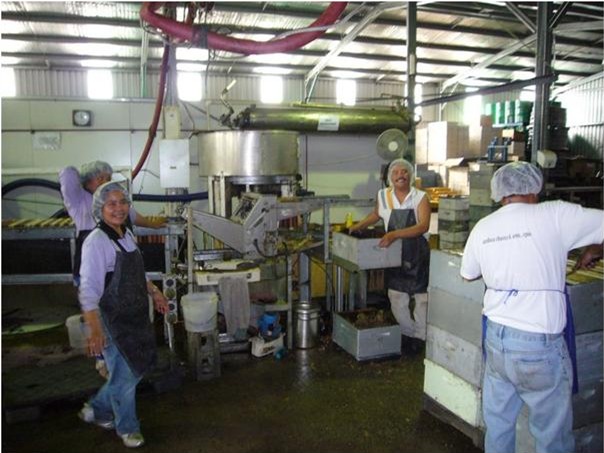
Happy employees/family at Ken and Shirley Olley’s honey house. There is a large hotroom visible behind the extractor and cappings spinner. Zita Sanchez, at left, is a technician with great experience in nosema in silkworms, who Ken hired for her expertise.
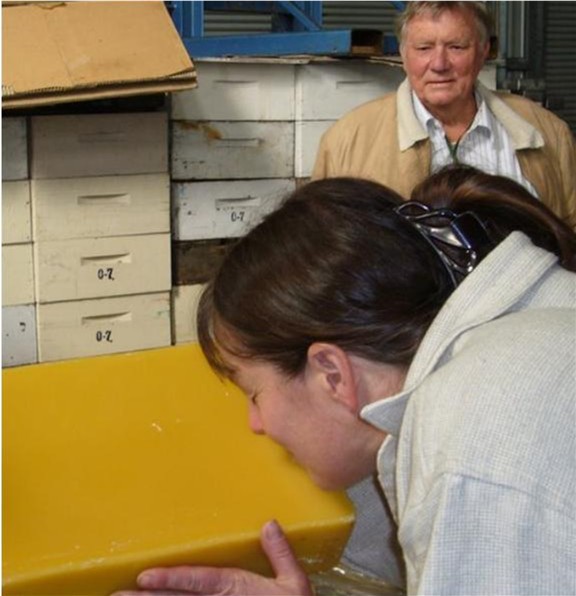
Stephanie smelling the delightful aroma of Ken Olley’s (in back) Tasmanian Leatherwood beeswax. Ken melts the wax gently, and holds it at 144°F for long settling, resulting in a clean, lovely product for the German organic market.
The honeys of Australia are of a wonderful and wide variety. They come with whimsical names, such as wandoo, mallee, karri, jarrah, woolybutt, blackbutt, white box, and stringy bark. But the flavors! Oh, the flavors! Some of our favorites were West Australian mallee (meaning multistemmed eucalyptus)–which tastes like rich melted butter, Wandoo or White Gum—butterscotch and caramel, and Tasmanian Leatherwood—too complex and exotic to describe!
Unfortunately, many of these exquisite honeys are sold in bulk and blended. But I met some beekeepers with more marketing savvy. Phil Sammut in WA, (a very sharp operator, who I will return to in a later article) purchased a piece of land on a busy highway from which to direct market his varietal honeys. When others were recently selling their honey wholesale for $2.00 a pound, Phil sold all he could produce at $11.00/lb.
Australian honey is exported and in demand worldwide, since it is currently chemical free. The Australians will need to decide if they wish to maintain this premium marketing aspect once varroa arrives.
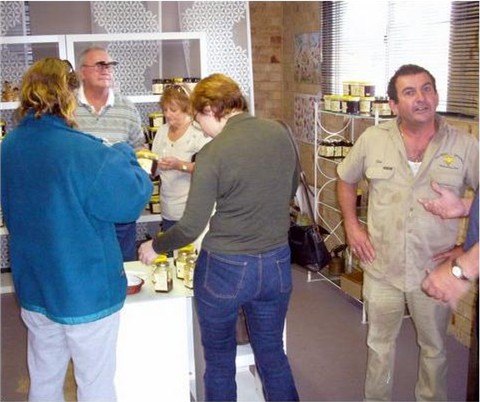
Phil Sammut (R) at his roadside sales room (usually staffed by his wife Liz). Phil is a bundle of entrepreneurial energy, and a very innovative and successful beekeeper.
On a humorous note, I was discussing the pollination of lucerne (alfalfa) with progressive beekeeper/organizer Leigh (Duff) Duffield, and told him that I sometimes labeled the alfalfa honey that I produce as “lucerne” because it gives it a more saleable sexy, European ring. He laughed and said that he labels his lucerne honey as “alfalfa” because Australians associate the name “lucerne” with animal fodder! Ah, the importance of name in marketing!
Excellent Innovation and Research
Australian beekeepers are an innovative lot, and the first one that I visited was Ken Olley, and his glowing wife, Shirley. I was able to go over Ken’s long history in Australian beekeeping through a black and white photo collection. He has always been an innovator and entrepreneur, having invented the articulated boom loader, and has developed bee nutritional feeds. He is currently focusing on nosema control (a large issue in Oz), and has a product out to be used as a preventative feed (I brought some home for testing, and will get write more about Ken’s operation in the future).
In WA, queen breeders Harry East and Ron Clark run an isolated mating program on Rottnest Island. They maintain a line of productive and gentle yellow (big emphasis on “yellow”) queens that remain genetically distinct from the local dark feral population [6].
Australia has a thriving export business of package bees that takes advantage of their reversed season. Warren Taylor is a large operator who I found very knowledgeable about all aspects of bee production. Another exporter with whom I’ve spent time is Terry Brown, who has traveled the world to seek out breeding stock, and to gain experience with varroa mite prior to its expected arrival in Oz. Terry is keen to promote breeding for varroa resistance.
I had previously spent time with almond pollination brokers Trevor and Carolyn Monson when they visited California last year, and was delighted to make contact again. Trevor manages pollination for vast corporate plantings of almonds. He expects to place 160,000 colonies in 2012! He is active in the field, and manages placement of the huge drops of 240 colonies, as well as water supplies for the bees via the trees’ drip emitters.
I have followed Australian honey bee research for some time, and have been very impressed by the research and practical reports offered by the Rural Industries Research and Development Corporation (RIRDC) [www.rirdc.gov.au/programs/hb.html]—they are a model for what a government agricultural research program is capable of.
Australia is home to world-class bee scientists, such as Graham Kleinschmidt (retired, but a pioneer in bee nutrition), Ben Oldroyd, Denis Anderson (who named Varroa destructor), Doug Somerville (“Fat Bees, Skinny Bees”), and Rob Manning. Rob is a meticulous researcher with whom I have been corresponding about bee nutrition. He is also an historian, artist, and orchid breeder!

Dr. Rob Manning, casual, at a pub after the WA conference. Rob is an expert on bee nutrition and pollen nutritional profiles, and has conducted research on feral bees, nosema, pollination and pollinator interactions.
We had the pleasure to spend some time in the state-of-the-art lab of Dr. Boris Baer, at the University of WA. His previous work in Switzerland was largely with bumblebees, and, among other things, detailed the importance of genetic variability in resistance to parasites. These days he has taken an interest in honeybees, prodded by exuberant third-generation beekeeper/researcher/breeder Tiffane Bates, who seems to be happily involved in all aspects of beekeeping in Perth. I hope for more great bee science to come from his lab!
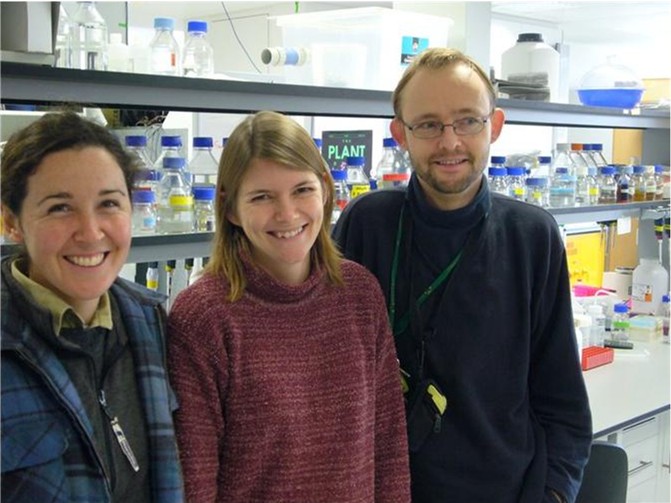
Tiffane Bates, technician Veronica Poland, and Dr. Boris Baer. Dr. Baer is an expert on bee reproduction, and is studying the way that bee semen changes with time while stored in the spermatheca of queen bees. Tiffane keeps busy—she works with both Dr. Baer and Dr. Manning, commercial bee breeder Ron Clark, plus runs her own small operation.
Australia is a big country, and the two weeks that we were there was not nearly enough. I hope to return so that I can spend more time in the yards and honeyhouses of the beekeepers to see more of how they do things down under!
I will follow this article eventually with articles on Australian innovations, loading methods (in conjunction with Chilean beekeeper Juanse Barros, who was visiting at the same time), and hot wax tanks.
Acknowledgments
I wish to express my fondest thanks to all the Australians who made us feel welcome, and especially to our wonderful hosts—Ken and Shirley Olley, Peter and Jenny Detchon, and Duff and Helen Duffield. Thanks also to Zita Sanchez, Trevor Weatherhead, Tiffane Bates, and South Australian Govt. Bee Inspector Michael Stedman.
References
1. www.honeybee.com.au/Library/gibsmuir.html
2. The future of pollinators for Australian agriculture http://www.publish.csiro.au/paper/AR01186
3. More Than Honey, THE FUTURE OF THE AUSTRALIAN HONEY BEE AND POLLINATION INDUSTRIES http://www.aph.gov.au/House/committee/pir/honeybee/report.htm
4. www.rirdc.gov.au/reports/HBE/01-052.pdf
5. http://www.honeybee.com.au/Library/pollen/nutrition.html
6. Chapman, NC, J Lim and BP Oldroyd (2008) Population Genetics of Commercial and Feral Honey Bees in Western Australia J. Econ. Entomol. 101(2): 272-277.



